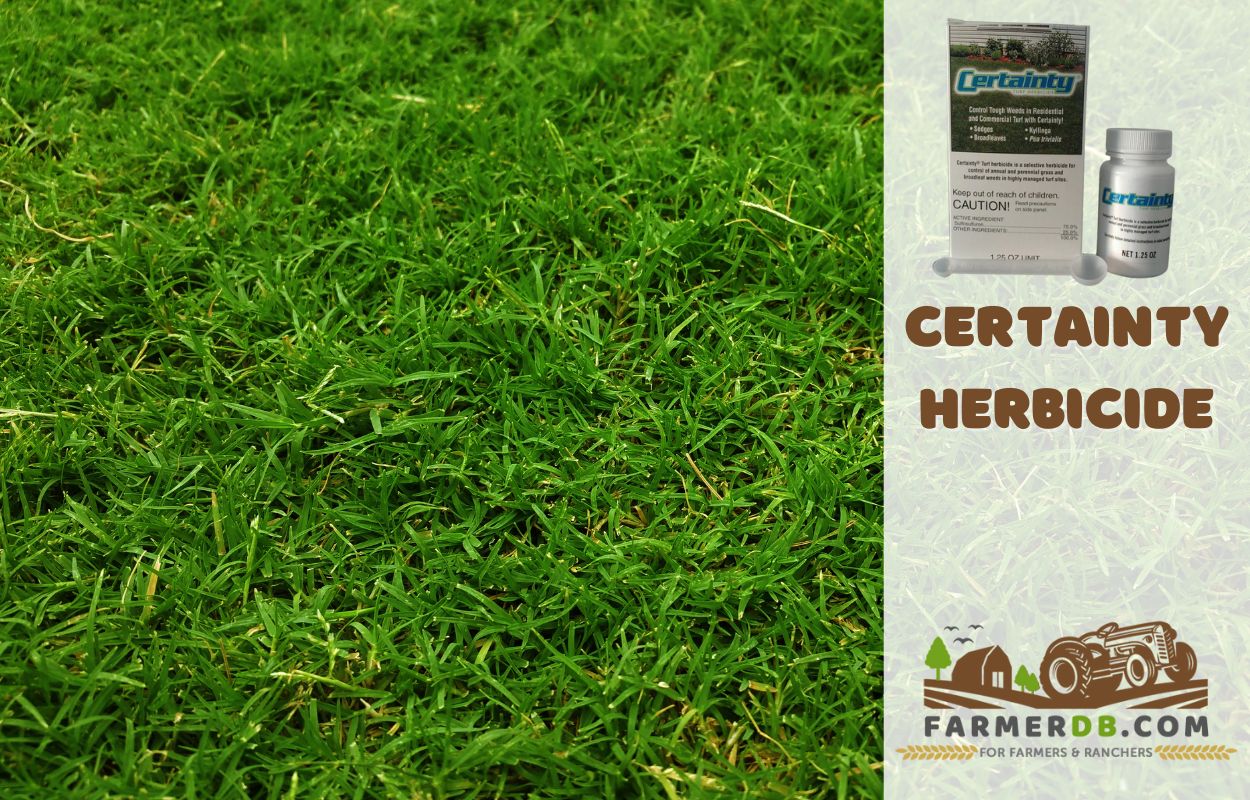Contents
- What is Certainty Herbicide?
- The active ingredients
- Where to use it
- How it works
- How Soon Will You See Results
- Mix Ratio
- How to Prepare it
- Surfactants, Adjuvants, Colorants, and Dyes
- Steps to apply it
- What does this herbicide kill?
- Is is safe for my grass?
- Warm-season turfgrasses information
- How to store it
- EPA Registration Number
What is Certainty Herbicide?
Certainty is a selective herbicide designed for controlling annual and perennial grass and broadleaf weeds in highly managed turf, ornamental, and native grass areas, offering post-emergence control with limited soil residual activity.
The herbicide comes in a water-dispersible granule (WDG) formulation.

The active ingredients
The active ingredient in this selective post-emergence herbicide is sulfosulfuron (75%). Sulfosulfuron is a systemic, selective herbicide that belongs to the sulfonylurea class of herbicides.
Where to use it
You can use this herbicide in various settings, such as highly managed turf, sod farms, native grasses, landscaped sites, and ornamental nurseries.
It can also be applied in residential and commercial areas, including golf course fairways, golf course roughs, hotel properties, cemeteries, athletic fields, apartment complexes, school grounds, retail sites, parks, public areas, and turfgrass seed farms.
How it works
The herbicide works selectively and systemically, focusing on unwanted weeds post-emergence. Once sprayed, it is taken in through the weed’s roots and leaves, inhibiting acetolactate synthase (ALS), which is vital for amino acid production. This blockage stops the growth, causing the weeds to die.
How Soon Will You See Results
Weeds that are affected by the herbicide stop growing within 24 hours, but it may take time for you to see any changes.
Usually, these weeds will begin to turn yellow or brown within 2 to 3 weeks after treatment.
Warm and moist conditions can make the herbicide work more quickly, while cold and dry weather can make it slower.
Mix Ratio
The herbicide comes with two scoops sizes: a small scoop and a large scoop, each providing distinct mixing ratio instructions.
Mixing Ratio for Small Scoop (0.16-gram scoop)
The table below shows how many scoop of the product are necessary to obtain the desired application rate when combined with 2 gallons of water.
| Desired Application Rate (ounces of product/acres) | Number of Small Scoops | Mix Volume (gallons of water) | Spray Rate (gallons/1000 ft2) |
|---|---|---|---|
| 0.75 | 3 | 2.0 | 2 |
| 1.00 | 4 | 2.0 | 2 |
| 1.25 | 5 | 2.0 | 2 |
For each gallon of water, incorporate 2 teaspoons (which is 1/3 fluid ounce) of nonionic surfactant.
Mixing Ratio for Large Scoop (0.8-gram scoop)
| Desired Application Rate (ounces of product/acres) | Number of Small Scoops | Mix Volume (gallons of water) | Spray Rate (gallons/1000 ft2) |
|---|---|---|---|
| 0.75 | 1 | 3.3 | 2 |
| 1.00 | 1 | 2.5 | 2 |
| 1.25 | 1 | 2.0 | 2 |
| 2.0 | 2 | 2.5 | 2 |
For each gallon of water, incorporate 2 teaspoons (which is 1/3 fluid ounce) of nonionic surfactant.
How to Prepare it
When preparing the tank mix of this herbicide, you must follow a specific order for the individual components. The order is the following:
- water
- water dispersible granules (the herbicide itself)
- water-soluble bags
- dry flowables
- emulsifiable concentrates
- drift control additive
- water-soluble liquids
- nonionic surfactants
Surfactants, Adjuvants, Colorants, and Dyes
When using surfactants, select a nonionic surfactant with a concentration of 0.25 to 0.5 percent by volume (equivalent to 1 to 2 quarts per 100 gallons of spray solution). Ensure that the nonionic surfactants contain at least 90 percent active ingredient. Avoid using nonionic surfactants or any additives that can lower the pH of the spray solution below pH 5. Surfactants containing d’Limonene, methylated seed oil, or crop oil concentrate (COC) may lead to temporary discoloration of turf.
Regarding colorants or dyes, the herbicide label indicates that they can be added, but doing so may reduce the effectiveness of the herbicide.
Steps to apply it
- Verify that it is the right time to apply the herbicide and that the weeds are at the proper growth stage for treatment. For the most effective results, ensure that target weeds are actively growing and have not been mowed for a minimum of 2 days both before and after the application.
- Select a day with ideal weather conditions. Avoid herbicide application when humidity levels are low, wind speeds exceed 10 mph, temperatures are excessively high or near freezing, or when rain is forecast within 24 hours after application.
- Prepare your personal protective equipment (PPE) for the herbicide application. According to the label, for agricultural use, you should be equipped with coveralls, shoes, socks, and chemical-resistant gloves made of nitrile rubber, neoprene rubber, or polyethylene.
- Begin preparing the solution by following the specific order of mixing. First, fill the tank with about three-fourths of the desired final volume. Check the correct ratio of herbicide on the label, measure it, and add it to the tank. Mix and shake the solution thoroughly, maintaining continuous agitation before spraying. Add the nonionic surfactant near the end of the filling process.
- Transfer the final solution into the desired application system. You can use a hand-held sprayer or any other herbicide application system. Do not apply this herbicide through any type of irrigation system.
- Spray it uniformly and ensure that you do not touch any desirable plants.
- After you finish, thoroughly clean the equipment used in the process. Use a 1-percent solution of ammonia (1 quart of ammonia for every 25 gallons of rinse water) to remove this herbicide from the equipment. Rinse very well with water until no visible residue remains.
Even though this herbicide is rainfast within two hours, it is recommended to avoid rain for 24 hours afterward to ensure a successful application and optimal results.
What does this herbicide kill?
This herbicide controls the following weeds:
| Common Name | Scientific Name |
|---|---|
| Kyllinga, false green | Kyllinga gracilima |
| Kyllinga, fragrant | Kyllinga sesquiflorus |
| Kyllinga, green | Kyllinga brevifolia |
| Nutsedge, purple | Cyperus rotundus |
| Nutsedge, yellow | Cyperus esculentus |
| Sedge, globe | Cyperus croceus |
| Sedges, annual | Cyperus spp. |
| Barley, little | Hordeum pusillum |
| Bedstraw, catchweed | Galium aparine |
| Bluegrass, bulbous | Poa bulbosa |
| Bluegrass, roughstalk | Poa trivialis |
| Burweed, lawn | Soliva pterosperna |
| Buttercup | Ranunculus arvensis |
| Chickweed, common | Stellaria media |
| Clover, white | Trifolium repens |
| Crowfootgrass | Dactyloctenium aegyptium |
| Dandelion | Taraxacum officinale |
| Garlic, wild | Allium vineale |
| Geranium, Carolina | Geranium carolinianum |
| Henbit | Lamium amplexicaule |
| Ivy, ground | Glechoma hederacea |
| Johnsongrass | Sorghum halepense |
| Mustard, wild | Sinapis arvensis |
| Pennycress, field | Thlaspi arvense |
| Pennywort, lawn (dollarweed) | Hydrocotyle sibthorpioides |
| Quackgrass | Elytrigia repens |
| Ryegrass, perennial | Lolium perenne |
| Shepherd’s-purse | Capsella bursa-pastoris |
| Switchgrass | Panicum virgatum |
| Violet, wild | Viola spp. |
| Woodsorrell, yellow | Oxalis stricta |
Is is safe for my grass?
The herbicide is safe for the following established warm-season turfgrasses: Bermudagrass, Bahiagrass, Buffalograss, Centipedegrass, Kikuyugrass, St. Augustinegrass, Seashore Paspalum, and Zoysiagrass.
Warm-season turfgrasses information
Sedge Control
- Kyllinga, false green
- Kyllinga, fragrant
- Kyllinga, green
- Nutsedge, purple
- Nutsedge, yellow
- Sedge, globe,
- Sedges, annual
Use the Herbicide at a rate of 1.25 oz/A once the weeds have developed to the 3- to 8-leaf growth stage. If necessary, a follow-up application of 1.25 oz/A can be made 4 or more weeks after the first treatment.
Tall Fescue Control
Administer 1.25 oz/A, then apply a second dose of 1.25 oz/A 21 to 28 days after the first application.
Dallisgrass Control in Bermudagrass
This application procedure involves MSMA, which may cause damage to common and hybrid Bermudagrass turf. Prior to large-scale use, it is advisable to test the following tank-mix recommendation on a small section to determine its suitability for your Bermudagrass management objectives.
When dallisgrass is actively growing, apply Certainty at a rate of 1.25 oz/A in combination with 2 lbs of MSMA per acre and 0.25% by volume of nonionic surfactant (1 quart per 100 gallons of spray solution). Repeat this tank mixture 2 to 4 weeks after the initial treatment.
For an alternative program, start with MSMA at 2 lbs AI/A along with 0.25% by volume of nonionic surfactant. After a two-week interval, apply 2 oz/A of Certainty. Two weeks later, reapply MSMA at 2 lbs AI/A with 0.25% by volume of nonionic surfactant.
Virginia Buttonweed (Diodia virginiana) Suppression
To suppress buttonweed, apply this product at a rate of 1.25 ounces per acre. This treatment will offer suppression or partial control of buttonweed for a duration of 4 to 6 weeks.
Annual Bluegrass (Poa annua) Management in Non-Overseeded Turf
For selective control of annual bluegrass, apply this product at 1.25 to 2.0 ounces per acre. Use the higher dosage in areas with heavy, established weed infestations. The best results are achieved when weeds are targeted in the early growth phase, before tillering occurs.
In dormant Bermudagrass, consider mixing this product with Roundup PROMAX® or Roundup QuikPRO® herbicides to enhance the range of vegetation that can be controlled. It is crucial to follow the label directions, precautionary statements, and all relevant information for both Roundup PROMAX and Roundup QuikPRO herbicides.
Annual Bluegrass (Poa annua) Management Before Overseeding with Perennial Ryegrass
Apply this product at 2.0 ounces per acre to effectively control Poa annua prior to overseeding warm-season turf with perennial ryegrass. Start applications following the germination of Poa annua and 7 to 10 days ahead of the overseeding date.
How to store it
The herbicide should be stored upright in their original containers, in a well-ventilated area, away from food, feed, and other chemicals to prevent contamination.
EPA Registration Number
The EPA Reg. No. of this herbicide is 59639-226.


